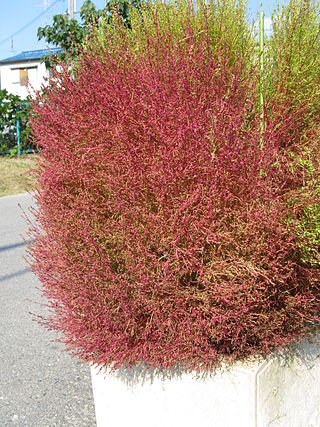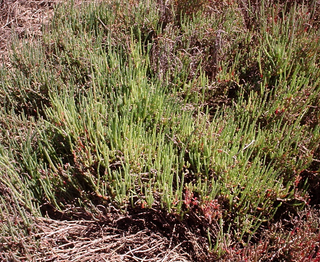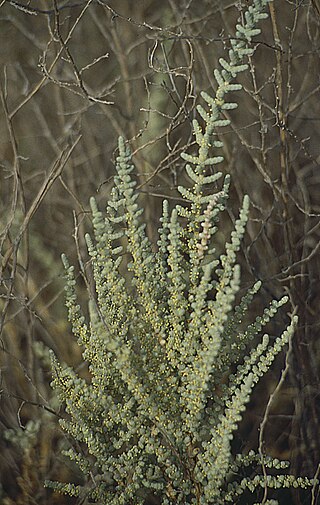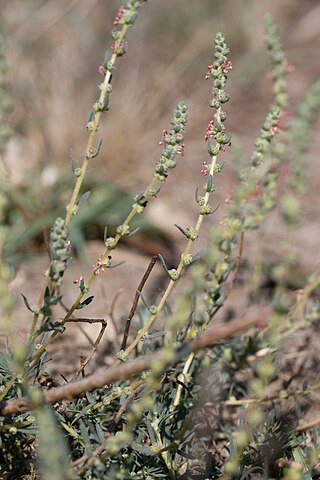
Amaranthaceae is a family of flowering plants commonly known as the amaranth family, in reference to its type genus Amaranthus. It includes the former goosefoot family Chenopodiaceae and contains about 165 genera and 2,040 species, making it the most species-rich lineage within its parent order, Caryophyllales.
Sarcocornia is a formerly recognized genus of flowering plants in the amaranth family, Amaranthaceae. Species are known commonly as samphires, glassworts, or saltworts. Molecular phylogenetic studies have shown that when separated from Salicornia, the genus is paraphyletic, since Salicornia is embedded within it, and Sarcocornia has now been merged into a more broadly circumscribed Salicornia. When separated from Salicornia, the genus has a cosmopolitan distribution, and is most diverse in the Cape Floristic Region of South Africa.

The Salicornioideae are a subfamily of the flowering plant family Amaranthaceae. Important characters are succulent, often articulated stems, strongly reduced leaves, and flowers aggregated in thick, dense spike-shaped thyrses. These halophytic plants are distributed worldwide. Many are edible

The Salsoloideae are a subfamily of the Amaranthaceae, formerly in family Chenopodiaceae.

The Chenopodioideae are a subfamily of the flowering plant family Amaranthaceae in the APG III system, which is largely based on molecular phylogeny, but were included – together with other subfamilies – in the family Chenopodiaceae, or goosefoot family, in the Cronquist system.

Salsola is a genus of the subfamily Salsoloideae in the family Amaranthaceae. The genus sensu stricto is distributed in central and southwestern Asia, North Africa, and the Mediterranean. A common name of various members of this genus and related genera is saltwort, for their salt tolerance. The genus name Salsola is from the Latin salsus, meaning "salty".

Kochia is a synonym of the genus Bassia, which belongs to the subfamily Camphorosmoideae of family Amaranthaceae.

Tecticornia is a genus of succulent, salt tolerant plants largely endemic to Australia. Taxa in the genus are commonly referred to as samphires. In 2007, the genus Halosarcia, along with three other Australian genera was incorporated into the genus.

Neokochia americana is a species of flowering plant in the amaranth family, subfamily Camphorosmoideae, known by the common name green molly.

Bassia scoparia is a large annual herb in the family Amaranthaceae native to Eurasia. It has been introduced to many parts of North America, where it is found in grassland, prairie, and desert shrub ecosystems. Its common names include ragweed, summer cypress, mock-cypress, kochia, belvedere, World's Fair plant, burningbush, Mexican firebrush, and Mexican fireweed, the provenance of the latter three names being the herb's red autumn foliage.
Neokochia californica is a species of flowering plant in the subfamily Camphorosmoideae of the amaranth family known by the common name rusty molly. It is native to the valleys and deserts of southeastern California and adjacent parts of Nevada, where it grows in dry, alkaline soils such as alkali flats and desert washes. This is a perennial herb or small shrub growing one or more sprawling, branching stems to a maximum height near 60 centimeters. The stems are lined with narrow, elongated, somewhat flattened fleshy leaves up to about a centimeter long. The leaves and stem are coated in grayish or brownish hairs. The inflorescence is made up of one or more tiny hairy flowers sprouting from the axils of the leaves.

Bassia is a genus of flowering plants in the family Amaranthaceae. They are distributed in the western Mediterranean to eastern Asia. Some occur outside their native ranges as introduced species.

The Polycnemoideae are a small subfamily of plants in the family Amaranthaceae, representing a basal evolutionary lineage. The few relictual species are distributed in Eurasia and North Africa, North America, and Australia.

The Suaedoideae are a subfamily of plants in the family Amaranthaceae.

Halocnemum is a genus of halophytic shrubs in the family Amaranthaceae. The plants are fleshy and apparently articulated with characteristic globular or short-cylindrical lateral branches, and reduced leaves and flowers. There are three or two species, occurring from Southern Europe and North Africa to Asia.

Sclerolaena birchii, commonly known as galvanised burr, is a perennial shrub native to inland Australia.

Camphorosma is a genus of flowering plants in the family Amaranthaceae, found in northern Africa, southern and eastern Europe, Crimea, Russia, Anatolia, the Caucasus, Iran, Afghanistan, Pakistan, Central Asia, the Altai, western Siberia, Xinjiang in China, and Mongolia. Annuals or subshrubs, they can be distinguished from closely related taxa such as Bassia by their flattened perianths which have four lobes, inflorescences with multicellular glandular hairs, a distinct C4 leaf anatomy type (called the Camphorosma type), and a chromosome count of 2n = 12.

Eriochiton is a genus of small shrubs in the family Chenopodiaceae, which are included in Amaranthaceae according to the APG classification. It contains a single species, Eriochiton sclerolaenoides, a subshrub endemic to Australia.

Grubovia is a genus of flowering plants belonging to the family Amaranthaceae.

Sclerolaena tricuspis, the giant redburr or three-spined Bassia, is a species of flowering plant in the family Amaranthaceae, native to eastern Australia. A shrub reaching 1 m (3 ft), it has slender terete leaves.



















